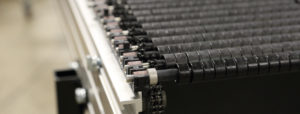By Klaus Daenzer, Senior Plastics R&D Engineer
Shuttleworth has been designing material handling conveyors for a wide variety of diverse customer applications for over 55 years. Whether glass, food, electronics, pharmaceutical or automotive components, each application process creates a unique set of demands on the rollers that convey that products along their path.
When Jim Shuttleworth asked me to come up with a single plastic material for rollers capable of performing in one of the company’s most demanding electronics projects, he was searching for something that would provide the customer with a lower cost option while enabling Shuttleworth to respond faster. Structurally, the material had to be able to maintain a high strength to weight ratio in order to achieve the goal of maintaining roller pressure at less than 4% of the carried load. Since many customers’ processes involve annealing, extreme temperature resistance was mandatory. Another important factor was for the electronics industry, the roller material itself had to be both electrically conductive and free of silicone oil. This led Shuttleworth to develop a custom material roller.
The customer had formulated a RTP 1300 Series conductive and lubricated polyphenylene sulfide (PPS) compound. With a tensile strength of 900 psi (62 MPa) and specific gravity of 1.54, the new material yielded a sufficiently strong, yet lightweight part. Shuttleworth’s EP-0047 rollers were the perfect solution as they were lighter than conventional steel rollers and can make use of very low drive pressure – greatly reducing wear and still gently conveying parts.
The properties of the PPS compound offered a continuous use temperature of 400 degrees Fahrenheit and excellent chemical resistance. The rollers were durable enough to pass the intense 6-month heat durability test. To make the material ideally suited for ESD (electrostatic discharge) sensitive uses, a conductivity package was added – resulting in reduced volume resistivity. This allowed the rollers to harmlessly bleed dangerous static charges away from any sensitive electronic parts they may convey.
Using a silicone additive is the traditional approach to decrease friction between surfaces in contact with one another. Often, a high loading of silicone will cause particles to migrate to the part’s surface, creating a source of potential contamination. Because of this, the electronics industry prohibits its use. To meet this specific challenge, Shuttleworth tailored a combination of PTFE and Fluoroguard synthetic oil into the PPS compound, providing lubricity superior to that of silicone. This allowed Shuttleworth to achieve both the necessary lubricity needed and the ability to eliminate the plate out common with higher loadings of PTFE.
To learn more about Shuttleworth’s electronics applications, visit our website at www.shuttleworth.com or visit us on YouTube at:
https://www.youtube.com/watch?v=1gGjbifdSt8&list=PLcEDuYWivuUdtB3h75rtaZIIo6CzkO2ma
